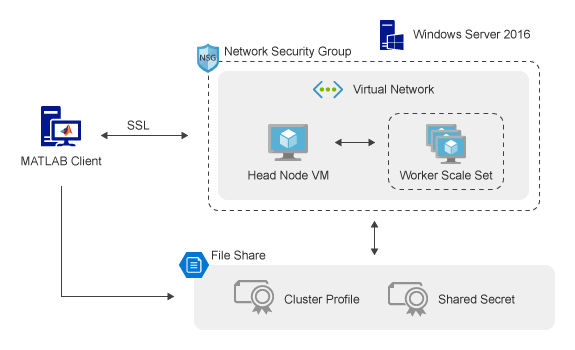从 Microsoft Azure Marketplace 运行 MATLAB Parallel Server
本主题介绍如何使用 Azure® 市场在 Azure 中快速部署和运行 MATLAB® Parallel Server™。云基础设施的弹性与 MATLABParallel Server 相结合,使您能够利用更多的计算资源并使计算保持接近数据。
任何拥有有效 MATLAB 许可证(包含 MATLAB Parallel Server 和 Azure 帐户)的人都可以在云中运行 MATLAB Parallel Server。此产品被称为 MATLABParallel Server (BYOL),因为您“自带许可证”。
要求
要完成这些说明,您需要:
包含 MATLAB Parallel Server 的 MATLAB 许可
Azure 资源管理器的应用知识
许可
默认情况下,Azure 市场中的 MATLABParallel Server (BYOL) 产品使用在线许可。下表总结了哪些许可证支持使用在线许可在云上运行 MATLAB Parallel Server。
| 许可证类型 | 云可用性 |
|---|---|
个人 - 以您的名义颁发且仅供您使用的许可证 | 您的许可证已在云中为 MATLAB Parallel Server 配置。 |
校园范围许可证 - 属于您所在学术机构且仅供您使用 | 您的许可证已在云中为 MATLAB Parallel Server 配置。 |
网络指定用户和并发 - 由许可证管理员在服务器上管理的许可证 所有其他许可证类型 | 请与您的许可证管理员联系。 许可证管理员可能需要对许可证进行一些更改,以使您能够在云中运行 MATLAB Parallel Server。要查找您的许可证管理员,请从 MathWorks® 许可证中心选择您的许可证,然后点击联系管理员。 管理员:有关此过程的更多信息,请参阅为云平台配置 MATLABParallel Server 许可。 |
要使用通过网络许可证管理器管理的许可证,您可以在 Azure 中创建云资源时指定网络许可证管理器的端口和主机名或 IP 地址。您可以指定现有许可证管理器的位置,也可以在云中部署新的许可证管理器。您必须确保许可证管理器可以与您的云资源通信。要使用 Azure 开发的 Azure 市场软件计划在 MathWorks 中部署网络管理器,请按照从 Azure 市场运行网络许可证管理器中的步骤进行操作。
在 Azure 中部署 MATLABParallel Server 资源
从市场配置和部署模板
使用以下步骤在资源组中配置和部署 MATLABParallel Server (BYOL) 资源。
导航https://portal.azure.com并登录您的 Azure 帐户。
在门户中,点击创建资源。
在市场中搜索“MATLAB 并行服务器”,并选择 MATLABParallel Server (BYOL) 产品。
点击产品页面上的创建开始设置。

设置进程使用资源管理器模板来帮助您配置虚拟机 (VM) 和网络设置。为了简化设置,许多字段都预先填充了合适的值。下表介绍了如何设置模板各个菜单中的各个选项。点击每个步骤结束时的下一步以进入下一个菜单。
菜单 选项 描述 基础
订阅
选择要使用的 Azure 订阅。
资源组
您可以从下拉菜单中选择一个现有的资源组,或者点击新建以创建一个新的资源组。如果选择现有资源组,则它不能有任何当前部署的资源。
区域
从下拉列表中选择一个区域。
集群设置
集群名称
为集群选择一个名称。默认名称是
myCluster。工作单元节点数
为运行工作单元而启动的 Azure 实例的数量。
每个节点的工作单元数量
每个实例上启动的 MATLAB 工作单元的数量。每两个 vCPU 指定一个工作单元,以便每个物理核心分配一个工作单元。例如,Standard_D64s_v3 实例有 64 个 vCPU,因此可以支持 32 个 MATLAB 工作单元。有关每个实例类型的 vCPU 数量的详细信息,请参阅https://learn.microsoft.com/azure/virtual-machines/sizes。
主节点实例类型
用于运行作业管理器的主节点的 Azure 实例类型。此节点上没有启动工作单元,因此该节点可以是比工作单元节点更小的实例类型。有关实例类型和大小的列表,请参阅https://learn.microsoft.com/azure/virtual-machines/sizes。 工作单元实例类型
用于工作单元的 Azure 实例类型。有关实例类型和大小的列表,请参阅https://learn.microsoft.com/azure/virtual-machines/sizes。 数据库卷大小
用于存储数据库文件的卷的大小(以千兆字节为单位)。如果将此值设置为 0,则不会创建单独的卷,并且根卷将用于数据库。 客户端 IP 地址 可用于从 MATLAB 访问集群的 IP 地址范围。该范围必须是有效的 IP CIDR 范围,形式为 xxxx/x。使用 xxxx/32 形式的值来限制仅对您的计算机的访问。 密码 为用户“matlab”选择管理员密码。使用远程桌面协议登录任何实例(主节点或工作单元)时都需要此密码。您的密码必须至少包含 12 个字符,并且符合 Azure 密码要求。有关密码要求的信息,请参阅创建虚拟机时的密码要求是什么? 确认密码 重新键入您选择的密码。 网络许可证管理器端口@服务器
如果您正在使用网络许可证管理器,请输入端口和主机名或 IP 地址。确保网络许可证管理器能够与您的 Azure 资源通信。要在 Azure 中部署网络许可证管理器,请参阅从 Azure 市场运行网络许可证管理器。
网络
虚拟网络
虚拟网络字段预先填充了名为
vnet01的新虚拟网络资源。您可以通过点击新建来配置新虚拟网络资源的名称、地址空间或子网。
您可以在下拉菜单中选择现有的虚拟网络资源。如果您选择使用现有资源,则模板不会创建任何新的虚拟网络资源。
子网
子网字段预先填充了名为
subnet-1的新子网及其关联子网地址。您可以在下拉菜单中选择所选虚拟网络的不同子网。
如果您选择了现有虚拟网络而不是创建新的虚拟网络,则可以点击管理子网配置来配置网络的子网。
审查并创建
—
当您进入审核和创建菜单时,Azure 会自动对前面屏幕上输入的信息运行一些最终验证检查。如果 Azure 发现任何错误,则必须先修复它们才能继续。
验证成功完成后,请查看 MathWorks 使用条款和隐私政策。在 Azure 中部署 MATLABParallel Server 后,您将承担所有相关费用。
对输入的值满意后,点击创建以完成设置并开始部署所选资源,或点击下载自动化模板以获取已完成模板的副本。
部署可能需要几分钟。部署完成后,您将在 Azure 门户中收到通知。
部署完成后,请按照从 MATLAB 连接到您的集群使用您设置的集群。
从 MATLAB 连接到您的集群
成功配置和部署 MATLABParallel Server (BYOL) 资源后,请按照以下步骤连接到您设置的集群。
从 Azure 门户,导航到包含已部署资源的资源组。
选择以 storage 结尾的存储帐户。
选择文件容器类型。
选择名为“共享”的文件共享。
下载
.settings文件。在客户端计算机上打开 MATLAB。
在 MATLAB 工具条中的并行下拉菜单中,选择创建和管理集群...。
点击“导入”。
选择下载的配置文件并点击打开。
点击“设为默认值”。
(可选)点击验证按钮来验证您的集群。
将云集群设置为默认集群后,下次运行并行语言命令(例如 parfor、spmd、parfeval 或 batch)时,MATLAB 将连接到该集群。第一次连接时,系统会提示您输入 MathWorks 帐户登录。第一次在工作单元上运行任务时,工作单元 MATLAB 可能需要几分钟才能启动。此延迟是由于配置实例磁盘造成的。这是一次性操作,后续任务开始得更快。
您的集群现在可以使用了。在客户端计算机上关闭 MATLAB 后,集群仍保持运行。
小心
使用配置文件和客户端 IP 地址范围来控制对云资源的访问。任何拥有 .settings 文件的人都可以从指定 IP 地址范围内的计算机连接到您的资源并在其上运行作业。
访问 MATLABParallel Server 端口要求
要从客户端 MATLAB 访问 MATLABParallel Server 集群,您的客户端计算机必须能够在特定端口上进行通信。确保网络防火墙允许以下传出连接。
| 所需端口 | 描述 |
|---|---|
| TCP 27350 至 27358 + 4*N | 端口 27350 至 27358 + 4*N,其中 N 是单个节点上的最大工作单元数 |
| TCP 443 | HTTPS 访问(至少)*.mathworks 和 *.microsoft.com |
| TCP 3389 | 用于访问集群节点的远程桌面协议 |
从 Azure 中删除 MATLABParallel Server 资源
使用完毕后,您可以删除资源组和所有相关资源,以节省成本。
登录到 Azure 门户。
选择包含您部署的 MATLABParallel Server (BYOL) 资源的资源组。
点击删除资源组图标可以删除组中部署的所有资源。
系统将提示您确认删除。
删除是最终决定,并且文件不会在部署之间保留。您必须创建资源才能使其再次可用。
Azure 中的 MATLABParallel Server 的架构和资源
在 Azure 中部署 MATLABParallel Server 会在资源组中创建多个资源。该部署为主节点设置单个 Azure VM、为工作单元设置 Azure 虚拟机扩展集 (VMSS)、用于连接到 VM 的具有公共 IP 地址的网络接口、用于控制网络流量的网络安全组以及用于资源之间通信的虚拟网络。下表总结了创建的资源。
| 资源名称 | Azure 中的默认资源名称 | 描述 |
|---|---|---|
| 虚拟机 | myclus-headnode | 集群主节点的计算实例。MATLAB 安装是 VM 映像的一部分,作业数据库存储在本地根卷上。也可以选择使用单独的数据磁盘。客户端和主节点之间的通信使用 SSL 进行保护。 |
| 虚拟机扩展集 | mycl-vmss | 用于启动工作单元实例的扩展集。扩展功能当前未使用。扩展集被配置为将扩展附加到在部署时配置为集群的工作单元节点的每个实例。客户端和工作单元之间的通信使用 SSL 进行保护。 |
| 网络接口 | myclus-headnodenic | 使主节点和工作单元能够与 Internet、Azure 和本地资源进行通信。 |
| 网络安全组 | mycluster-nsg | 允许或拒绝往返于源和目标的流量。 |
| 虚拟网络 | vnet01 | 使资源能够相互通信。如果选择现有的虚拟网络资源,则模板不会创建该资源。 |
下图总结了这些资源的架构。

虚拟机软件
提供了预配置的 Windows® VM,以简化部署。VM 包含以下软件:
MATLAB、Simulink®、工具箱和对 GPU 的支持。
运行 MATLAB 所使用的许可证决定了哪些产品和工具箱可供您使用。但是,所有产品都安装在虚拟机上,因此
ver命令返回所有产品的列表。要将新产品添加到您的许可证,请参阅产品和服务。附加功能:Deep Learning Toolbox™ Model for AlexNet Network、Deep Learning Toolbox Model for GoogLeNet Network 和 Deep Learning Toolbox Model for ResNet-50 Network.
市场与参考架构
Azure 市场产品仅运行最新版本的 MATLAB Parallel Server。如果您希望运行 MATLAB Parallel Server 的旧版本,或对模板和自动化脚本进行更深入的自定义,则可以改用 MATLAB Parallel Server Microsoft Azure 参考架构。
支持
如果您遇到意外问题,请先搜索 MATLAB Answers 查找解决方案。很可能其他人也遇到了同样的问题并已经解决了。
如果问题仍然存在,或者 MATLAB Answers 上没有关于该问题的任何相关帖子,请联系技术支持。